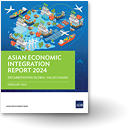Five Steps to Economic Resilience in the Caucasus and Central Asia
The ability of the economies of the Caucasus and Central Asia to effectively respond to external shocks critically depends on their cooperation in diversifying trade and transport routes. The right policies and development of the Middle Corridor is a key to success.
In the last several years, many countries of the Caucasus and Central Asia – particularly Azerbaijan, Georgia, Kazakhstan, Kyrgyz Republic, Tajikistan, Turkmenistan, and Uzbekistan – have been experiencing the impacts of various shocks, including the COVID-19 pandemic, climate change-inflicted disasters, and geopolitical conflicts.
In 2020-2022, these shocks resulted in international energy and food price hikes, as well as interruptions in supply chains and in the movements of people and goods.
So far, the economies of the Caucasus and Central Asia have demonstrated a remarkable resilience to these shocks. Despite the earlier estimates of a significantly decreased economic growth, especially for 2022, the region averaged 2.4% growth in 2020-2022; and the trade in goods grew in 2022 by a remarkable 34% over 2021.
These short-term developments, however, should not conceal the long-term challenges that became evident in 2022–2023. Many economic growth fundamentals—the ability to access foreign markets, smooth supply chains, access to advanced technologies, jobs for labor migrants and others—have been questioned by these shocks.
High product and geographic concentration of exports and the dependence on a handful of transit routes inherited from the former Soviet Union is a major source of vulnerabilities. Therefore, for many years, the governments in the region have been discussing measures to diversify trade flows and the transport and transit routes serving this trade.
In 2022–2023, when real risks to international transit emerged, these countries demonstrated a strong impetus to take practical steps towards the diversification.
The diversification of trade requires these economies develop production capacity with better links to new potential markets. The interdependence of their economies and the need to achieve economies of scale (not always possible within national borders) call for strengthening regional cooperation across the countries.
This requires developing transport and transit routes connecting the Caucasus and Central Asia with external markets, harmonizing procedures and technical regulations for trade in goods and services, coordinating the use of water and other natural resources, sharing human capital services, and other actions. Many Caucasus and Central Asia countries are part of the Central Asia Regional Economic Cooperation (CAREC) Program, which can act as a platform for such efforts.
Hard infrastructure and institutions are the most demanding elements when it comes to developing transit routes and alternative transport. Weighing all possible directions, considering the realities on the ground, one option stands the most feasible and promising—the Trans-Caspian International Transport Route also known as the Middle Corridor.
The Middle Corridor is a multimodal transport route traversing Eurasia by rail, road and sea from the People’s Republic of China via Central Asia, Caspian Sea, Caucasus, Black Sea or Tüaut;rkiye to Southern Europe and Middle East. Initially seen as purely transit route for containerized goods connecting the People’s Republic of China with the western destinations, these days the Middle Corridor is a key transport and transit route serving the trade among Caucasus and Central Asian countries and with partners to the west.
To effectively respond to external shocks, economies in the Caucasus and Central Asia must unite in diversifying their trade and transport routes, with the development of the Middle Corridor being a crucial step in this collective effort.
The Middle Corridor’s role in serving long-haul Eurasian transit is not promising due to the high costs of crossing many borders and the need to repeatedly switch from one transport mode to another, as well as the availability of existing cheaper alternatives. For the Caucasus and Central Asia, however, the Middle Corridor can play a key role as a resilient mechanism and the only viable diversification option for trade with Europe and other partners.
Importantly, the Middle Corridor is already serving a large part of the Caucasus and Central Asia’s intra-regional trade, which is currently small (5.4% of these economies’ total trade turnover in 2022) and, hence, has large potential to serve the region’s trade diversification.
The Middle Corridor currently faces significant challenges in reaching its full potential, including institutional complexities with a diverse range of stakeholders, cumbersome border and customs procedures, and inefficient logistics due to irregular ferry services and port congestion. Additionally, the limited capacities of ports and transportation networks, alongside the environmental impact of elevated carbon emissions from multimodal transport methods, further complicate its development and efficient operation.
For the sustainable development of the Middle Corridor and other trade diversification efforts, the following actions are needed:
- Prepare a well-thought-out strategy of the Middle Corridor development coordinated between multiple stakeholders
- Reduce trade costs and introduce green solutions through lowering non-tariff barriers and infrastructure development
- Implement reforms supporting the development of entrepreneurship and lower production costs to improve the ability to react swiftly to emerging market opportunities
- Diversify export destinations and import sources, which includes more active participation in the multilateral trade system and accession to the World Trade Organization for economies that have not joined the organization
- Strengthen regional cooperation for the development of cross-border infrastructure, logistics, human resources, production quality assurance systems, and other purposes.
To effectively respond to external shocks, economies in the Caucasus and Central Asia must unite in diversifying their trade and transport routes, with the development of the Middle Corridor being a crucial step in this collective effort.
Original article was published at the Asian Development Blog and duplicated here with permission from the authors. *




